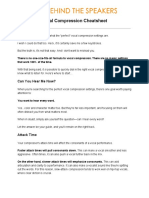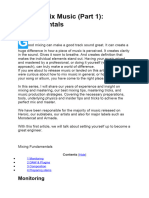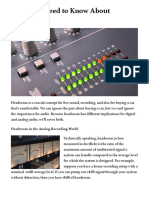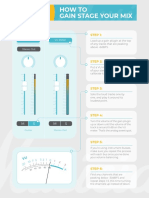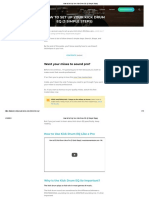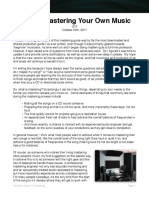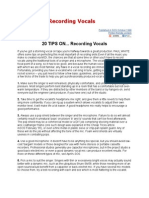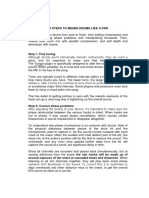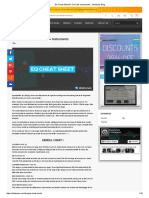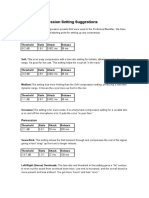0 ratings0% found this document useful (0 votes)
342 views100 pagesVarious Compression Tips Qaikfd
Uploaded by
XenophonCopyright
© © All Rights Reserved
We take content rights seriously. If you suspect this is your content, claim it here.
Available Formats
Download as PDF or read online on Scribd
0 ratings0% found this document useful (0 votes)
342 views100 pagesVarious Compression Tips Qaikfd
Uploaded by
XenophonCopyright
© © All Rights Reserved
We take content rights seriously. If you suspect this is your content, claim it here.
Available Formats
Download as PDF or read online on Scribd
You are on page 1/ 100
COMPRESSION
TIPS
Allrights reserved.
No part of this publication may be reproduced, distributed, or transmitted
in any form or by any means, including photocopying, recording, or other electronic
or mechanical methods, without the prior written permission of the publisher,
except in the case of brief quotations embodied in critical reviews and certain
other noncommercial uses permitted by copyright law. For permission requests,
write to the publisher, addressed “Attention: Permissions Coordinator,” at the address below.
st.14 13/13
Tetovo, Macedonia
1220
www.themixingtips.com
© 2019 Tosho Nikoloski
{ US g
(es
SOK OX CK OM
IMPORTANCE OF COMPRESSION
Never neglect compression. Nothing upsets the balance of a mix quite like
fluctuating volume levels: They make vocalists sound insecure and musicians,
sound clumsy, so use plenty of judicious Cocpressiqn to flatten the lgyels to
Gur asee sometimes bio gentle compressors are smoother than one firm one.
as
ve = mixing) tips)
es aN ies (O)meraie)
ae) SSO) SIMIC
Spend some time listening to the effect of various compression
noises, making them much more intimate; on guitars it can bring out
ait sound of fingers stroking strings or the rattle of hands on wood.
eect cnet u team times, but you do need tolearn
how to control them.
jean
a ae
ae Ne) To)
ee [rena
Ps 0 ees = seo
COMPRESSOR SETTINGS
Never neglect compression. Nothing upsets the balance of a mix
Colic MCHA CeU rel aTe m0) Ulead f=) MM NAT) Maar Con oce- Ieee] ae
insecure and musicians sound clumsy, so use plenty of judicious
compression to flatten the levels to consistency - sometimes two gentle
compressors are smoother than one firm one.
Mumbled
‘word
Uncompressed
Compressed
COMPRESSION TIP.
Sometimes using an extreme threshold setting makes it easier to
hear and dial in the attack and release times.
Once you have those set up, back the threshold down.
This is especially a great trick to try when you are playing around
with an unfamiliar compressor and are trying to get to know how
Lise bale CT nelleliy a TEC
NO COMPRESSION =1:1 RATIO
2:1 RATIO
5:1 RATIO
SOFT-KNEE
10:1 RATIO
HARD-KNEE
THRESHOLD
-cm Coe
Ae
DE-ESSER ONLY!
Ifyou have over-sibilant vocals and the high end sounds very
bright, the best way to handle it is a de-esser. People are using
cutting the wave and lowering the volume or EQing out the certain frequency
but that is wrong approach to this issue. Locate the sibilant from 6k to 9khz
and apply de-esser to that point. —
aa cc
S enn
LEASE rats wae
RELEP ml \
m9
Bena En
LOOKA
PG a aV NEG @a NDEs
The second way to fix the issue with your bass masking the kick is the’
sidechain compression. Best way and most natural way to do it is to
sidechain the bass for the exact lenght of the kick body to come in.
That will give enough space for the kick to be heard and forthe bass to recover
without making any noticable changes. ee
Veet) 1), Le
Easy way to make your kick more to sound live is to duplicate the etd
cut the subs and the very highs on it, EQ boost around 2khz
(depending what note is it and where is the sweetspot for that particular sample)
and then go with hard compression for over 8gb gain reduction. Mixit then with
the main stem gently to taste. ee
MVS a ane
Add a sample of another snare in the pool with a character to your
existing snare. Compress and distort it, EQ in some lows and also add
astereo reverb to it. Now mix that with your snare to)taste and you will
have unique snare hit that no-one had it before.
A Siz:
VINTAGE VOCAL MIX TIP
7
iin
To get a little of a vintage flavour on your vocal you can beost high
shelf (over 10k) and also boost the low mids (around 3k). Slightly use
parallel distortion and hard compressed reverb with long predelay. Using
vintage compressor will add more to the sound that you are looking for
AIRY VOCAL MIXTIP-
The first issue to getting the“airy” vocals are the harshness that they:
are bringing if you overcrank the high end. Instead, try to copy your vocal,
crank with high shelf at 9k-10k, but add hard de-esser and hard compression,
Mix it with your main vocal channel until your goal.
MASSIVE GUITARS ON CHORUS he :
‘Send guitars to buss. Put compressor on it.
During chorus, automate up 2db so that compressor kicks in & fattens em!
Aside from the compressor, you can always spread them in the stereo field so
they can sound even bigger!
EXPLOSIVE SNARETIP ¢
Duplicate the snare. Apply heavy compression to the duplicated track
and go with fast attack and release to have better-sustain on it. After you
CETUS CMU Mera Ua eRe Kelme ar TRI ULUKe 1M [Oecd Ks AM Ua scot ale
you want. Mix in with the original stem to taste.
THICK VOCAL TIP Bsvc0e
Again copy the main vocal and do the processing onit. Apply pitch
shifter and add 10ms delay - add 10 cents up and.down on eachiside.
Cutoff the top end and mix it with your main vocal up to taste. This will bring
out the richness and make the vocal more thick and roundy.
|
ADDING POP TO MAIN VOCAL
Make your vox pop out of the mix:
Copy vox, push wide 4khz bell, compress extremely hard
with faster release. Then mix it up with your main vocal to taste to add
POP in the vocal. Putting vintage compressor will get you nicecolor on the 4khz
MINHA EBON
‘Always gate your main hits in the drum set, like snare, toms andthe | F
‘drum kick -if there is any leaking in the microphones. In that situation;
you will need to play with your overheads channels for stereo imaging and
never forget your room mic. That is the stem that can take out or give life
to your whole drum set.
EDM SYNTH/LEAD PROCESSING
When mixing EDM leads, you need to focus on the main motive of
the track. Me personally i prefer mixing the EDM leads into clarity Enc)
in mono (center). Aside from kick and bass, the next most important ma 6
thing in EDMis the lead. Getting it right will make your song way better.
Cut below 400hz and boost with high shelf above 2k. Parallethard compress
if you want to add more ounchiness in the sound.
OTT SIREN S167
Be careful of any effect that makes a signal louder, as the volume
increase alone can give the illusion of a‘better’ sound. Compression
is a good example of this. Louder isn’t necessarily better, so always be
sure to A/B your new and old settings to make sure that you are actually
improving the sound rather than just boosting it.
Compressed Dynamic Range
Threshold Point
ait}
OVER COMPRESSION
rl
Ifyou compress the life out of all the elements in your track then | ‘3
that’s exactly how your finished mix will sound too.
And while this is a standard technique in dance music these days,
even in that genre there are limits. So dial back the settings alittle sometimes,
and use sidechaining to add some bounce and life_
Bass Gara
of music genres where an effect is activated by an audio track.
In other words, it’s using an alternative audio source to
trigger a processor. The alternative source is set to a threshold,
which when exceeded activates the effect.
Try using faster releases when compressing drums and other
FexceU so nW ATCC CM el Mats [ete in UNR Cc la snc}
(the initial burst of sound) but maintain the decay of the original sound.
On'that note, be careful to not crush the transients of a particularly percussive
or choppy transient audio signal with an attack time that’s too quick.
Amplitude
Threshold
Time
DYNAMIC PROCESSING TIPS
When compressing acoustic guitars, try slower attacks for a picked
or plucked acoustic, and faster attacks for a strummed acoustic.
Picked or plucked acoustics tend to have more individual transients
Biarelee-le-d oo magr- le Ra Svea) Kola eg ape)
A faster attack will help to even out the attack a
PARALLEL COMPRESSION TIP
Parallel Compression is a technique that involves mixing a lightly A 7
compressed signal with a heavily compressed (and sometimes
high-pass filtered) version of the same signal. This allows for a smoother
result, with crisp and level sound in the high end without any loud peaks
or squashed transients. A typical ratio might be.50% of each signal.
LEAD VOCAL DYNAMICS
‘Try this on a lead vocal: first, set a limiter with a high ratio to grab the
extremely hard notes and then follow it with a compressor using a
gentler ratio (say 3:1) to do the overall processing. This will allow the
compressor to not work as hard on those peaks, andthe vocal will sound
less‘pumping'and more natural.
RELEASE AND TEMPO TIP
Experiment with matching the release time on a compressor to the tempo
of your song. Having the release synchronize with, say, a driving 8th |
note rhythm on a bass or guitar can really add life to the Fearon nea
Anjeasy way to figure this out is to set the compressor on your track
with a very low threshold, then adjust the release time
until the signal sounds natural (i.e.: not pumping).—
TUBE LEVELING AMPLIFIER
TLA-I008
@Qxee
HARD COMPRESSION TIP
Don't be afraid to experiment with extreme compression. Limiting ambient
microphones on drums can give a sense that the drums were recorded
ina much larger room than they actually were. But be careful: When
not set properly, this can completely smother the sound of your drums,
and, in extreme cases, you'll get that infamous ‘gated reverb’
sound of the 80s on your drum kit! _—
VOCAL DE-ESSING
Ifa vocal does have some harshness, it's common to use a DeEsser to solve
the problem. De-essers are compressors that focus on a specific
frequency range, and they're typically used to remove harshness
caused by sizzling“S”and“T”consonant sounds in vocal tracks.
Simply use the monitor feature to listen to the range youre de-essing,
and find the offending frequency. Then, set the threshold soit reduces that
range when it becomes harsh.
COMPRESSING PERCUSSIONS
Compressing percussion requires much higher ratios, as well as
quicker attack and release times. Ratios between 5:1-8:1, though
heavy, are recommended. When a percussion sound is too short,
smoothing out the transient peaks allow us to hear the decay and
fap momo ae Maule Ke| <1 NAn ole gael [aot
Aneta ee EPO ge
ny
COMPRESSING BAGK VOCALS
WIT! ZOE DA ENGINEER
When mixing background vocals, try to compress hard. Increase yourthreshold
until your getting around 6-10dbs of gain reduction then mS
. ae Me ¥ ae Sa ant
adjust the make up gain. This will help with any dynamic issues, GN Ixil
help blend the background vocals together with the lead vocals,
and it will help reduce any random notes sticking out in the mix that
might draw the listeners ear away from the mix.
COMPRESSING VOCALS
WITH ZOE DA ENGINEER:
lalways use a slow attack on lead vocals and a fast attack on background vocals.
Usually when mixing vocals you do the opposite of what you did
NC
ltd te hvele lea UIMO NI NM Lie lp oar CR Ye here} Ce
XI
sounding the way you want them to sound. It gives the vocals a TI PS SF.
a
bigger sound while still having the lead vocals have the biggest ee
presence. You must mix the lead vocals first before getting to the
background vocals.
SIDECHAINING VOCALS TO MUSIC
like to set my vocal level to what | think sounds right, as my starting point.
The main thing I'm listening for is that the music is loud enough and that it
still has impact when the vocal stops. At the end of the mix, I'll set up
a music “submix” separate from the lead vocal. Then | sidechain the
vocal to a compressor on the music submix. At most, | want 1B of
gain reduction on the music when the vocal is singing.
Send
Channel 1 Return
PARALLEL COMP. FORVOCALS
If you're going for a modern, in-your-face vocal, it's common to use parallel
compression. Simply send the vocal to an aux channelwith an aggressive
compressor (like the CLA-76 or dbx 160), and smash it to smithereens. Don't be
afraid to use high ratios, fast attack and release times, and low thresholds.
Then, blend ina bit of the hyper-compressed signal to taste. This will help keep
the vocal forward while still retaining the natural dynamics of the original take.
SERIAL COMPRESSION
Vocals are a very dynamic instrument. They go from soft to loud in ani
nstant—sometimes randomly. When you're trying to create consistency ina song,
they tend to stick out. So you want to use a compressor to control those dynamics
and smooth out your vocal. More specifically, you want to use multiple compressors.
It’s called serial compression. Serial compression is a technique Ps ceo 4
where you use 2-3 mild compressors instead of 1 heavy compressor.
SIDECHAINING OVERHEADS
A range of cool effects can be created by putting a compressor/gate onthe
OM altro Ken Tae M OTN MG LCelMaN UTR Cee a Lol nia
Key a frequency-conscious gate from the snare to emphasise the
airy overhead signal with each snare hit; or compress the overheads
MiMi de @coKe cl men eo MN UN lag Neal
ROUP/BUSS COMPRESSION
Ratios are typically kept low, around 2:1. Attack times are generally slow to
allow the transients of the kit to punt rough. Release times can
vary depending on the tempo of the track, but it’s not uncommon
to use the auto release function found on many compressors like
the SSL G-Master Buss Compressor.
poo
een BEFORE COMPRESSION
By using some good old-fashioned volume automation beforehand,
you can reduce the amount of work the compressor is having to do, BAA
, , > Mix!
and in return introduce less compression-caused issues such aq
ES
as pumping and distortion, This will ease the load on the compressor
and prevent it from jumping all over the place, resulting in fewer noticeable artifacts.
mixing tips
/
MIX BUSS COMPRESSION.
Itis important to choose the appropriate type of mix bus compressor for the music.
Different. compressor types will yeild different sonic results. Some may work better
for certain genre's than others. Be’sure to choose the right compressor for your mix.
VCA compressors are known for adding punch to a mix. The AudioScape G-Stereo
use this solid-state design. VCA's are known for gluing the mid-range and causing
the music bréath. These are a great choice for more aggressive styles of music
like rock, hip-hop, and edm. 16) mixing tips
COMPRESS FOR PUNCH
Use a compressor on your drums to fatten them up, and make them punchy.
Use a slow attack if you want some snap, or use a faster attack to have them fat.
Another option is to send a copy of the drums to another bus, compress.it heavily
and blend the compressed drums with the un-compressed (or lightly compressed)
original to get the best of both world. Ic) mixing tips
PARALLEL COMPRESSION TIP
Parallel compression involves duplicating the desired track, and then slamming the
duplicate with a compressor to the point that it sounds unpleasant on its own.
Then, you slowly blend the main track with the compressed one until the desired
result is achiéved:It's common on vocals and drums, but you.can try it on anything
when you want to add some aggression or excitement toa mix. [f mixing tips
ed
SIDECHAINING THE REVERB
Balancing a dry vocal signal against the ‘right’ amount of reverb isn't always easy.
If you want a generous reverb level to fillin the gaps between vocal phrasessthat
amount can often seem too much ee avocalist tsings, drowning the vocal
‘performanceand distancing the listener Sree There are two effective ways
‘to ee problem. The first is: s that you can add Sa ora to (he
Ie} sit
EE auxlaty return, Ping eet re
{6) mixing tips
— ry ~
COMPRESSING THE BASS ~
Start witha release time of 150ms, and move it faster or slower from there. That
should be a good starting point. Alternatively, If your compressor has an auto-release
function, use’t. It will often work better than manually setting the release time. Start
compressing with a slow attack time as well. Try around 20-40ms. If the transients of
your bass notes are inconsistent, you can make the attack time faster. If some notes.
are clicky and others are qulet, a faster attack time might be needed. (6) mixing) tips)
e ‘awacoueren
AUDIOSCAPE
COMPRESSION TIP
Ifyou compress the life out of all the elements in your track then that’s exactly how
your finished mix will sound too. And while this is a standard technique in dance
music these days, even inthat genre there.are limits. So dial back the seas al
ittle sometimes, ahd use sidechaining to.add some bounce and life. mixing. tips,
Peony
COMPRESSOR ON OUTPUT
In the analogue mixing days it was common practice to place a compressor on the
main output to keep the signal below OdB and add a bit of weight, but with modern
digital mixing you can keep things low enough not to peak and still preserve the
range. Don‘ risksquashing the life out of your music - leave those sorts of decisions
oe La posi eS a cal aN Sn SRS
as Si Mek cee!
Uncompressed Audio Compressed Audio
Pe COMPRESSION IMPORTANCE. .
S the balance of ami xq ite like
- COMPRESSIONTIP
Spend: Sor a eng tothe effect of various compression Setncs on different
instruments: On ec it can enhance breath oss making them nue more
intimate;on guitars it can, bring out the sour of fingers stroking strifigs 6 orther rattle
of hands on wood, All oft these Serene be useful attimes, but You do. need
lean bow tocontrolther, ‘ ee ye Op rinse ‘ips|
This dictates when the
compressor clamps down
Bass Gara
But this gets compressed
when the kick drum hits
SIDECHAIN OR DUCKING
Side chain ducking is most frequently used. Normally, a compressor works by using
the input signal level crossing a pre-set threshold as a trigger to reduce the level of
oe
the same signal. Compressors with side chai
inputs allow the user to trigger —
oa
ee coe Slow Attack + Slow Release
Thesetwo parameter val either (ase or break the transient energy ¢ of 2 track. To
help Cewa this, picture an ADSR envelope for the volume output fiveur to- be |
compressed track. dansaied this visualbStice into the anack and cs etimes 4
Smixingl |
BUSS COMPRESSION
Thisis, agreat tool for gluing together sounds into a cohesive element. Take, for.
note
{a} imbxing) tips)
dq. fabfilter Pro-DS
:
LN |
cle Et) ea
Cc aaa
sa ee} eee
ata
SINGLE
vocat
CeCe ce |
tere lar aes ater
por re)
eg
Le) ise} pol Biter Meeker
ee a
ee a iodo Y ote
Poumon iam OO OT
on ay bad
ey
Aon
Perey Fy ioe
Panes a =<
Pee
SIDECHAINING TO MORE ELEMENTS
Let me first quickly explain what Sidechain Compression is. In essence it's decreasing
the volume of one track when another one's volume goes up. It can be used to create
a cool pumping effect if you sidechain something to the kick. To create this effect
A ' we
“When it comes eS voice, use a ratio around 5a, depending on the style of music and
how much you want ittobe once You can even compress all the way up to
10:1, meaning that there will be very little difference between “loud” and “soft” But t!
would be based on the style of music. Start with 5:1, play along with the mix, and see
how. mutch vocals can.remain on top of everything else without you-having to change
the fader setting too much. Use a soft knee 50 that there isn’ ‘tany sudden penance in
dynamies when the processor is activated. Uses fast attack time, a dont t go tao. fast.
: Something like 30ms. should be sufficient. Z Te)z eran ps}
SIDECHAIN MELODIES TO VOCALS
This isavery handy Brogess. If your instrument is fighting for volume wn your oak.
ut joutdont want keep tu in pied ubin ty nix whenever
PCr CR
clerc3
LIMITER AS A MIXING TOOL
Limiting is often thought of as a mastering-only tool. But in reality, the purposes
of limiting stretch far beyond mastering. Did you know that a lot of professional
mixing engineers use limiting to flatten uD bass layers? Also, did you know that
lepitnecap be the | best ei to flatten out transient peaks (whi icin tir, Bile
E help maximize your headroom)?
o
weg sibs)
Berit: MIX WITH LIMITER | oe
This one is a personal preference. In my opinion, when you mix xing a Limiter, you
2
get a sense of how your mix will sound after the mastering process. It changes the
whole dynamic behavior of your mix and pushes you to make Gifferent and better
decisions during the session. Just put a simple limiter on your master bus, Li style,
compress about 3 to 8db and try it: Be catefulinot to overdo it because you might
= . Po _
lose your sense of what's right for the mix. 1G) mixing tes
Fast Attack + Fast Release Slow Attack + Slow Release
ATTACK SETTINGS
Use a medium to long attack of about 30ms or above and the compressor will
allow the initial attack of an instrument to pass through unaffected. This results
ina more rhythmic sound and is great if that is the purpose of the instrument.
On the other hand using.an immediate attack, with a release of around 30 - 50ms
will pull back the rhythmic elements and bring forward the harmohic ‘aSpects
> . : os
© ofaninstrument) fe Pe ee To mixing tips
Attack Time
Amplitude
Release Time
Time
~ RELEASE SETTINGS ©
pees determines how | many milliseconds (ms) it takes your compressor to stop
Oe fo Maree, Bran ® - 3
anal d I release
() mixin
ot L)
MULTIB ND COMPRESSION ON VOCALS
As vocalists move between different registers, the tone of their voice can change.
For, example, when the vocalist moves toa lower register, their voice might start
be eee am z Wet ae a
Blue - original
o1enoe - See
y Z rig
Esc ~~ OVERCOMPRESSION eee
Compression s isa Gangeiots toolasit’s very easy t to quickly fae too much ofa
shod chs When starting out yo should see us compressor eee but not
Gain Reduction
Amount
Input Level Output Level
6 dB above the Threshold
2 dB of gain at the Output
Ratio
COMPRESS WITH CARE
Use compression (with care). fproperly used, a compressor can tame Jolting
jumps in level and output a more stable vocal signal. Its typically mech easier and 4
AUTOMATE THEN COMPRESS
Use automation. Although compressors help stabilize level changes incurred by a
vocalist’s performance, they don’t adjust the vocal level according to the music,
arrangement, or emptio of the son Acompresso won'tki when the Ue
sq or loud and when the voca stob ordin et 0
"KEEP THE NITIAL GAIN STAGE.
Be careful of any effect that makes a signal louder, as the volume increase alone
can give the. illusion ¢ ofa’better’ sound. Compression is a good eeriple of this.
Louder isn't heccascarly better, so always be sure to ay your new and fold eettings
to make sure that you are actually improinathe sound rather thane just’
+ eo fo
» boosting it. ‘
5}) mixing tips
i enero
(GC) mixing tips
NO COMPRESSION > 1:1 RATIO
2:1 RATIO
5:1 RATIO
SOFT-KNEE
10:1 RATIO
HARD-KNEE
THRESHOLD
rm
ia Gt Hard Knee
SOFT VS HARD KNEE
“Knee” refers to how quickly the compressor clamps down on the signal once it
surpasses the threshold. With hard knee compression, the gain reduction applied
signal exceeds the level e
Really Nice Tp ag e peer Veet le RNCI773}
Compressr @@@@@@06@ e e
60 O5
Bacal
10, °
THRESHOLD.
CHECKING COMPRESSOR SETTINGS
Spend some time listening to the effect of various compression settings on
different instruments. On vocals it can enhance breath noises, making them much
more intimate; on guitars it can bring out the sound of fingers Boog strings or
the rattle of hands 0 on wood. All ofthese elements can be useful lattes De you
© doneedto learnt 1
eda
[Sidechain ]@){__ea_|
[1-Kit-909 Kiev] | | =|[O][-C}
=)
ce (
OQ ¢
SIDECHAINING FOR EDM
Sidechain compression can be a useful technique to create space for elements
that need to be upfront (yet they occupy the same space for the sound in the
sound spectrum). Since the "bass area’ is often the problem area for most, side
chain compression gets « applied where te kick drum is the source, yet other -
insruments get fed) with the sidechain compression 1 This ies it this’ ©" i ;
CLEANERVOCALS
Set up your reverb and/or delay sends on your vocals, after your send effect set
up a sidechain compressor and then direct the sidechain to the vocal itself. This
Gain Reduction
Threshold
Fast Attack|
.
‘Gain Reduction
_ VOCAL COMPRESSION ATTACK _
When compressing lead vocals in a mix, adjusting the attack time can have a
major effect on their sound. If the vocalist has quick dynamics that jump out of 4
the mix, using a fast attack time can help to control this. It can thicken the vocals
by bringing out more of the body of words and pulling back consonants.
Use caution with this approach however as a vocal part can quickly lose it’s
dynamic edge. It also has a far less transparent sound to it which an" ;
hinder a track.
thixing! tips
FINDING BEST ATTACK TIME
Acommon trick is to use an 1176 compressor like the CLA-76 to apply a healthy
dose of gain reduction at a high ratio like 12:1 or 20:1 to bring out the attack of the
transients. To find the best attack time:
- Start with the slowest attack and fastest release.times
- Slowly increase the attack time until you start to shave off the initial transient of
the bass, then back off
-Slowly.decrease the oe time untilthe ceteris starts to’bréathé"i in
«time with the songs.” enya a Ne 1S jaca ps
~ FINDINGBESTRELEASETIME =
The tlease setting controls how long it takes for the compressor to let goofa a, *
signal, raat release times are also « great fori increasing the f perceived loudness of
atrack. At low levels of gain reduction, fast release speeds sound the most mae) 4
However, when used at high ratios, fast release times can make tracks sound more
gritty and aggressive, Just be careful, extreme compression with a fast release
time can cause an unwanted pumping sound. Use a compressor's VU meter to
watch how the needle moves. Is it moving intime with the music? if 50, youre
probably getting close to the right attack/release times.
thixing! tips
tars F This is the first FX channel added to the main vocal.
[olere)
Itincludes compression, slight EQ fix and saturation.
‘The second FX channel has the timed effects
such as reverb and delay as well as additional
ee processing that affects only the effects added.
=O eo] = 0
VOGAL PARALLEL PROCESSING
When you are working for a client that wants to keep some of the settings he
previously set on the vocals, best way to continue the work is by parallel process.
Doing it this way, you will keep the original signal intact, while adding your own
flavour to it. When doing it, add hard compression to even out the transients and
put additional processing to it. Saturation/distortion and various timed effects
_ are best applied trough FX channel. >
Pei ee.
mixing tips
arya
NU
———«
LEVEL DETECTI
CONTROL SIGNAL
AUDIO DIO
Us GAIN REDUCTION oni aUe
Le) aie 3
SIDECHAIN EXAMPLES
You can use subtle sidechain compression throughout your project to create
space and movement. If two elements are clashing and you can't fix it with eq,
consider using subtle sidechain compression instead.
Examples include:
-Sidechaining the bass to the snare.
-Sidechaining the reverb/delay to the lead synth.
-Sidechaining the percussion loops to the lead synth. : ws
» “Sidechaining the claptto the kick.» se
You might also like
- Level Headed: Gain Staging in Your Daw Software100% (1)Level Headed: Gain Staging in Your Daw Software5 pages
- Which Compressor Plugin Should I Choose For My Mix - Waves100% (1)Which Compressor Plugin Should I Choose For My Mix - Waves15 pages
- 4 Types of Audio Compressors & When To Use Each of ThemNo ratings yet4 Types of Audio Compressors & When To Use Each of Them9 pages
- Audio Mastering Jonathan Wyner PDF DownloadNo ratings yetAudio Mastering Jonathan Wyner PDF Download52 pages
- Waves Alternative Products - Alternate Plugin ListNo ratings yetWaves Alternative Products - Alternate Plugin List3 pages
- How Much Headroom Before Mastering Should I LeaveNo ratings yetHow Much Headroom Before Mastering Should I Leave7 pages
- How To Set Up Your Kick Drum EQ (3 Simple Steps) PDFNo ratings yetHow To Set Up Your Kick Drum EQ (3 Simple Steps) PDF15 pages
- How To EQ A Vocal Infographic ProSoundFormulaNo ratings yetHow To EQ A Vocal Infographic ProSoundFormula1 page
- Audio Compression Notes (Data Compression)No ratings yetAudio Compression Notes (Data Compression)35 pages
- 9 Steps To A Better Static Mix - Cheat SheetNo ratings yet9 Steps To A Better Static Mix - Cheat Sheet4 pages
- How To Mix Music (Part 3) : Stereo Image & Mixing Tips: Heroic - AcademyNo ratings yetHow To Mix Music (Part 3) : Stereo Image & Mixing Tips: Heroic - Academy8 pages
- EQ Cheat Sheet For Over 20+ Instruments - Abletunes Blog100% (2)EQ Cheat Sheet For Over 20+ Instruments - Abletunes Blog10 pages
- From Zero To Studio Compression CheatSheetNo ratings yetFrom Zero To Studio Compression CheatSheet7 pages
- Compression Cheatsheet - The Band GuideNo ratings yetCompression Cheatsheet - The Band Guide6 pages
